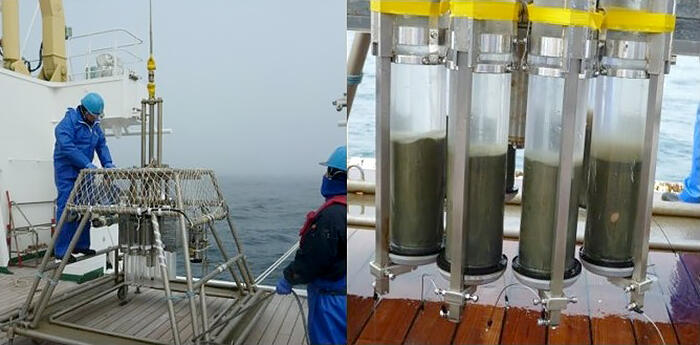A research group led by Associate Professor Atsushi Ooki of the Faculty of Fisheries Sciences, Hokkaido University, has investigated the spatiotemporal distribution of organic iodine gases in Funka Bay, Hokkaido, and the northern Bering Sea. The researchers found that the concentration of ethyl iodide (C2H5I), a type of organic iodine gas, increases at the surface of marine sediments after the spring, when phytoplankton blooms occur in Funka Bay. They also observed high concentrations of phytoplankton on the sediment surface in the northern Bering Sea and southern Chukchi Sea shelf areas.

Provided by Associate Professor Atsushi Ooki, Hokkaido University
The research group used the research voyages of the Ushio-maru and Oshoro-maru, training vessels affiliated with the Faculty of Fisheries Sciences, to conduct oceanographic observations in Funka Bay, Hokkaido (2018-19), and the northern Bering Sea and southern Chukchi Sea (July 2017 and July 2018).
The oceanographic observations included taking samples of sediment and seawater. Sediment sampling was conducted using an Ashura core sampler on the Ushio-maru and a multiple core sampler on the Oshoro-maru. Water immediately above the sediment and interstitial water in the sediment were collected by cutting the sediment at a thickness of 1 cm and using a syringe. Seawater samples were collected vertically using a CTD water sampling device.
According to the vertical time cross sections in Funka Bay, the concentration of ethyl iodide in the sediment increased immediately after the diatom bloom in March, and the concentration in bottom water increased from the following month. High concentrations of ethyl iodide were also found on the sediment surface and bottom waters of the continental shelves of the southern Chukchi Sea and northern Bering Sea. The researchers observed ethyl iodide after a few days following a dark incubation experiment, in which diatom aggregates collected during a bloom in Funka Bay were sealed and stored in glass bottles. They also found that organic iodine gas is produced from phytoplankton deposited on the seafloor.
This demonstrated that ethyl iodide, always a minor component in the ocean and atmosphere, quickly jumps to be a major component in marine sediments. This action suggests that ethyl iodide occurs when phytoplankton produced at the ocean surface settles to the seafloor and the plant cells then die.
"We sample sediments at a depth of about 100 meters in the ocean every month to measure the chemical components they contain, and the results are in line with our predictions," explains Dr. Ooki. "Chemical changes in marine sediments are complicated by microbial activity, and microbial activity probably contributes to the generation of ethyl iodide. In the future, we would like to know why ethyl iodide is generated, focusing on the function of microorganisms. There are still many mysteries about iodine in the oceans, so we would like to have a full understanding of the entire oceanic iodine cycle."
Journal Information
Publication: Communications Earth & Environment
Title: Marine sediment as a likely source of methyl and ethyl iodides in subpolar and polar seas
DOI: 10.1038/s43247-022-00513-7
This article has been translated by JST with permission from The Science News Ltd.(https://sci-news.co.jp/). Unauthorized reproduction of the article and photographs is prohibited.




